Application of the Vortex Search Algorithm to the Phase-Balancing Problem in Distribution Systems
Abstract
1. Introduction
1.1. General Context
1.2. Motivation
1.3. Review of the State of the Art
1.4. Contributions
- ✓
- It is possible to obtain a global optimal solution for the PB problem via the parameterization solution method with a sensitivity analysis between the number of candidate solutions and the number of iterations.
- ✓
- The solution developed from the interaction of the DVSA and the three-phase iterative sweep method can be implemented for any radial or meshed unbalanced distribution system. Likewise, the set of optimal connections for loads in the system is not limited by the number of nodes.
1.5. Document Organization
2. Mathematical Formulation
2.1. Objective Function
2.2. Constraints
3. Methodology Proposed
3.1. Master Stage: Vortex Search Algorithm
3.1.1. Initial Solution
3.1.2. Candidate Solutions
3.1.3. Replacement of the Current Solution
3.1.4. Process of Radius Reduction
3.1.5. Evaluation of Fitness Function
3.2. Slave Stage: Three-Phase Iterative Sweep Method
4. Test Systems
4.1. 8-Node Test System
4.2. 25-Node Test System
4.3. IEEE 37-Node Test System
5. Evaluation of the Initial Configurations
5.1. Computational Validation
5.2. 8-Node Test System
- ✓
- The proposed three-phase iterative sweep method with an error of takes 5 iterations and a run-time of 0.0905 s to obtain similar results to those reached by DigSILENT©. In Figure 9 it is shown that the behavior in terms of voltage per phase is the same for both solution methods.
- ✓
- From Table 4 it is determined that the maximum error between the data acquired by the three-phase iterative sweep method and DigSILENT© for the voltage profiles at each phase are 0.0073% for phase A, 0.0114% for phase B, and 0.0144% for phase C. On the other hand, from Table 5 the maximum errors for active power loss are 0.0007% for phase A, 0.0436% for phase B, 0.0250% for phase C, and 0.0104% for total loss, which demonstrates that the results obtained with the three-phase iterative sweep method are reliable, since these are comparable with specialized software, such as DigSILENT©.
5.3. 25-Node Test System
- ✓
- The three-phase iterative sweep method proposed with an error of takes 9 iterations and 0.1882 s of processing time to obtain similar results to those reached with the power-system software DigSILENT©. In Figure 10, it is shown that the behavior in terms of voltage per phase is the same for both solution techniques.
- ✓
- From Table 6 it is determined that the maximum error of the results obtained between the three-phase sweep iterative method and DigSILENT© for the voltage profiles at each phase are 0.0098% for phase A, 0.0104% for phase B, and 0.0051% for phase C, respectively. By the other side from Table 7 the maximum error for the active power loss per phase are 0.0115% for phase A, 0.0015% for phase B, 0.0071% for phase C, and 0.0032% for the total loss, which demonstrates that the results obtained with the developed three-phase iterative sweep method are reliable, since they can be compared with the specialized software for power systems DigSILENT©.
5.4. IEEE 37-Node Test System
- ✓
- The proposed three-phase iterative sweep method with an error of takes 9 iterations and a processing time of 0.2919 s to obtain similar results to those reached with the specialized software DigSILENT©. In Figure 11, it is shown that the behavior in terms of voltage per phase is the same for both solution methods.
- ✓
- From Table 8 it is determined that the maximum error for the voltage profiles obtained between the three-phase iterative sweep method and DigSILENT© at each phase are 0.0068% for phase A, 0.091% for phase B, and 0.0110% for phase C. On the other hand, from Table 8 the maximum error for the active power losses are 0.0003% for phase A, 0.0185% for phase B, 0.0131% for phase C, and 0.0038% for the total loss. This demonstrates that the results obtained with the developed three-phase iterative sweep method are reliable, since these are comparable with the specialized power-system software DigSILENT©.
6. Results Obtained: Methodology Proposed
6.1. Computational Validation
6.2. 8-Node Test System
6.3. 25-Node Test System
6.4. 37 Nodes Test System
7. Conclusions and Future Works
Author Contributions
Funding
Institutional Review Board Statement
Informed Consent Statement
Data Availability Statement
Acknowledgments
Conflicts of Interest
Appendix A. Electrical Parameters
| Line | Node i | Node j | Conductor | Length (ft) | (kW) | (kvar) | (kW) | (kvar) | (kW) | (kvar) |
|---|---|---|---|---|---|---|---|---|---|---|
| 1 | 1 | 2 | 1 | 5280 | 519 | 250 | 259 | 126 | 515 | 250 |
| 2 | 2 | 3 | 2 | 5280 | 0 | 0 | 259 | 126 | 486 | 235 |
| 3 | 2 | 5 | 3 | 5280 | 0 | 0 | 0 | 0 | 226 | 109 |
| 4 | 2 | 7 | 3 | 5280 | 486 | 235 | 0 | 0 | 0 | 0 |
| 5 | 3 | 4 | 4 | 5280 | 0 | 0 | 0 | 0 | 324 | 157 |
| 6 | 3 | 8 | 5 | 5280 | 0 | 0 | 267 | 129 | 0 | 0 |
| 7 | 5 | 6 | 6 | 5280 | 0 | 0 | 0 | 0 | 145 | 70 |
| Type of Conductor (Ω/mi) | |||
|---|---|---|---|
| 0.093654 + 0.040293i | 0.031218 + 0.013431i | 0.031218 + 0.013431i | |
| 1 | 0.031218 + 0.013431i | 0.093654 + 0.040293i | 0.031218 + 0.013431i |
| 0.031218 + 0.013431i | 0.031218 + 0.013431i | 0.093654 + 0.040293i | |
| 0.15609 + 0.067155i | 0.05203 + 0.022385i | 0.05203 + 0.022385i | |
| 2 | 0.05203 + 0.022385i | 0.15609 + 0.067155i | 0.05203 + 0.022385i |
| 0.05203 + 0.022385i | 0.05203 + 0.022385i | 0.15609 + 0.067155i | |
| 0.046827 + 0.0201465i | 0.015609 + 0.0067155i | 0.015609 + 0.0067155i | |
| 3 | 0.015609 + 0.0067155i | 0.046827 + 0.0201465i | 0.015609 + 0.0067155i |
| 0.015609 + 0.0067155i | 0.015609 + 0.0067155i | 0.046827 + 0.0201465i | |
| 0.031218 + 0.013431i | 0.010406 + 0.004477i | 0.010406 + 0.004477i | |
| 4 | 0.010406 + 0.004477i | 0.031218 + 0.013431i | 0.010406 + 0.004477i |
| 0.010406 + 0.004477i | 0.010406 + 0.004477i | 0.031218 + 0.013431i | |
| 0.062436 + 0.026862i | 0.020812 + 0.008954i | 0.020812 + 0.008954i | |
| 5 | 0.020812 + 0.008954i | 0.062436 + 0.026862i | 0.020812 + 0.008954i |
| 0.020812 + 0.008954i | 0.020812 + 0.008954i | 0.062436 + 0.026862i | |
| 0.078045 + 0.0335775i | 0.026015 + 0.0111925i | 0.026015 + 0.0111925i | |
| 6 | 0.026015 + 0.0111925i | 0.078045 + 0.0335775i | 0.026015 + 0.0111925i |
| 0.026015 + 0.0111925i | 0.026015 + 0.0111925i | 0.078045 + 0.0335775i |
| Line | Node i | Node j | Conductor | Length (ft) | (kW) | (kvar) | (kW) | (kvar) | (kW) | (kvar) |
|---|---|---|---|---|---|---|---|---|---|---|
| 1 | 1 | 2 | 1 | 1000 | 0 | 0 | 0 | 0 | 0 | 0 |
| 2 | 2 | 3 | 1 | 500 | 36 | 21.6 | 28.8 | 19.2 | 42 | 26.4 |
| 3 | 2 | 6 | 2 | 500 | 43.2 | 28.8 | 33.6 | 24 | 30 | 30 |
| 4 | 3 | 4 | 1 | 500 | 57.6 | 43.2 | 4.8 | 3.4 | 48 | 30 |
| 5 | 3 | 18 | 2 | 500 | 57.6 | 43.2 | 38.4 | 28.8 | 48 | 36 |
| 6 | 4 | 5 | 2 | 500 | 43.2 | 28.8 | 28.8 | 19.2 | 36 | 24 |
| 7 | 4 | 23 | 2 | 400 | 8.6 | 64.8 | 4.8 | 3.8 | 60 | 42 |
| 8 | 6 | 7 | 2 | 500 | 0 | 0 | 0 | 0 | 0 | 0 |
| 9 | 6 | 8 | 2 | 1000 | 43.2 | 28.8 | 28.8 | 19.2 | 3.6 | 2.4 |
| 10 | 7 | 9 | 2 | 500 | 72 | 50.4 | 38.4 | 28.8 | 48 | 30 |
| 11 | 7 | 14 | 2 | 500 | 57.6 | 36 | 38.4 | 28.8 | 60 | 42 |
| 12 | 7 | 16 | 2 | 500 | 57.6 | 4.3 | 3.8 | 28.8 | 48 | 36 |
| 13 | 9 | 10 | 2 | 500 | 36 | 21.6 | 28.8 | 19.2 | 32 | 26.4 |
| 14 | 10 | 11 | 2 | 300 | 50.4 | 31.7 | 24 | 14.4 | 36 | 24 |
| 15 | 11 | 12 | 3 | 200 | 57.6 | 36 | 48 | 33.6 | 48 | 36 |
| 16 | 11 | 13 | 3 | 200 | 64.8 | 21.6 | 33.6 | 21.1 | 36 | 24 |
| 17 | 14 | 15 | 2 | 300 | 7.2 | 4.3 | 4.8 | 2.9 | 6 | 3.6 |
| 18 | 14 | 17 | 3 | 300 | 57.6 | 43.2 | 33.6 | 24 | 54 | 38.4 |
| 19 | 18 | 20 | 2 | 500 | 50.4 | 36 | 38.4 | 28.8 | 54 | 38.4 |
| 20 | 18 | 21 | 3 | 400 | 5.8 | 4.3 | 3.4 | 2.4 | 5.4 | 3.8 |
| 21 | 20 | 19 | 3 | 400 | 8.6 | 6.5 | 4.8 | 3.4 | 6 | 4.8 |
| 22 | 21 | 22 | 3 | 400 | 72 | 50.4 | 57.6 | 43.2 | 60 | 48 |
| 23 | 23 | 24 | 2 | 400 | 50.4 | 36 | 43.2 | 30.7 | 4.8 | 3.6 |
| 24 | 24 | 25 | 3 | 400 | 8.6 | 6.5 | 4.8 | 2.9 | 6 | 4.2 |
| Type of Conductor (Ω/mi) | |||
|---|---|---|---|
| 0.3686 + 0.6852i | 0.0169 + 0.1515i | 0.0155 + 0.1098i | |
| 1 | 0.0169 + 0.1515i | 0.3757 + 0.6715i | 0.0188 + 0.2072i |
| 0.0155 + 0.1098i | 0.0188 + 0.2072i | 0.3723 + 0.6782i | |
| 0.9775 + 0.8717i | 0.0167 + 0.1697i | 0.0152 + 0.1264i | |
| 2 | 0.0167 + 0.1697i | 0.9844 + 0.8654i | 0.0186 + 0.2275i |
| 0.0152 + 0.1264i | 0.0186 + 0.2275i | 0.981 + 0.8648i | |
| 1.928 + 1.4194i | 0.0161 + 0.1183i | 0.0161 + 0.1183i | |
| 3 | 0.0161 + 0.1183i | 1.9308 + 1.4215i | 0.0161 + 0.1183i |
| 0.0161 + 0.1183i | 0.0161 + 0.1183i | 1.9337 + 1.4236i |
| Line | Node i | Node j | Conductor | Length (ft) | (kW) | (kvar) | (kW) | (kvar) | (kW) | (kvar) |
|---|---|---|---|---|---|---|---|---|---|---|
| 1 | 1 | 2 | 1 | 1850 | 140 | 70 | 140 | 70 | 350 | 175 |
| 2 | 2 | 3 | 2 | 960 | 0 | 0 | 0 | 0 | 0 | 0 |
| 3 | 3 | 24 | 4 | 400 | 0 | 0 | 0 | 0 | 0 | 0 |
| 4 | 3 | 27 | 3 | 360 | 0 | 0 | 0 | 0 | 85 | 40 |
| 5 | 3 | 4 | 2 | 1320 | 0 | 0 | 0 | 0 | 0 | 0 |
| 6 | 4 | 5 | 4 | 240 | 0 | 0 | 0 | 0 | 42 | 21 |
| 7 | 4 | 9 | 3 | 600 | 0 | 0 | 0 | 0 | 85 | 40 |
| 8 | 5 | 6 | 3 | 280 | 42 | 21 | 0 | 0 | 0 | 0 |
| 9 | 6 | 7 | 4 | 200 | 42 | 21 | 42 | 21 | 42 | 21 |
| 10 | 6 | 8 | 4 | 280 | 42 | 21 | 0 | 0 | 0 | 0 |
| 11 | 9 | 10 | 3 | 200 | 0 | 0 | 0 | 0 | 0 | 0 |
| 12 | 10 | 23 | 3 | 600 | 0 | 0 | 85 | 40 | 0 | 0 |
| 13 | 10 | 11 | 3 | 320 | 0 | 0 | 0 | 0 | 0 | 0 |
| 14 | 11 | 13 | 3 | 320 | 85 | 40 | 0 | 0 | 0 | 0 |
| 15 | 11 | 12 | 4 | 320 | 0 | 0 | 0 | 0 | 42 | 21 |
| 16 | 13 | 14 | 3 | 560 | 0 | 0 | 0 | 0 | 42 | 21 |
| 17 | 14 | 18 | 3 | 640 | 140 | 70 | 0 | 0 | 0 | 0 |
| 18 | 14 | 15 | 4 | 520 | 0 | 0 | 0 | 0 | 0 | 0 |
| 19 | 15 | 16 | 4 | 200 | 0 | 0 | 0 | 0 | 85 | 40 |
| 20 | 15 | 17 | 4 | 1280 | 0 | 0 | 42 | 21 | 0 | 0 |
| 21 | 18 | 19 | 3 | 400 | 126 | 62 | 0 | 0 | 0 | 0 |
| 22 | 19 | 20 | 3 | 400 | 0 | 0 | 0 | 0 | 0 | 0 |
| 23 | 20 | 22 | 3 | 400 | 0 | 0 | 0 | 0 | 42 | 21 |
| 24 | 20 | 21 | 4 | 200 | 0 | 0 | 0 | 0 | 85 | 40 |
| 25 | 24 | 26 | 4 | 320 | 8 | 4 | 85 | 40 | 0 | 0 |
| 26 | 24 | 25 | 4 | 240 | 0 | 0 | 0 | 0 | 85 | 40 |
| 27 | 27 | 28 | 3 | 520 | 0 | 0 | 0 | 0 | 0 | 0 |
| 28 | 28 | 29 | 4 | 80 | 17 | 8 | 21 | 10 | 0 | 0 |
| 29 | 28 | 31 | 3 | 800 | 0 | 0 | 0 | 0 | 85 | 40 |
| 30 | 29 | 30 | 4 | 520 | 85 | 40 | 0 | 0 | 0 | 0 |
| 31 | 31 | 34 | 4 | 920 | 0 | 0 | 0 | 0 | 0 | 0 |
| 32 | 31 | 32 | 3 | 600 | 0 | 0 | 0 | 0 | 0 | 0 |
| 33 | 32 | 33 | 4 | 280 | 0 | 0 | 42 | 21 | 0 | 0 |
| 34 | 34 | 36 | 4 | 760 | 0 | 0 | 42 | 21 | 0 | 0 |
| 35 | 34 | 35 | 4 | 120 | 0 | 0 | 140 | 70 | 21 | 10 |
| Type of Conductor (Ω/mi) | |||
|---|---|---|---|
| 0.2926 + 0.1973i | 0.0673 − 0.0368i | 0.0337 − 0.0417i | |
| 1 | 0.0673 − 0.0368i | 0.2646 + 0.19i | 0.0673 − 0.0368i |
| 0.0337 − 0.0417i | 0.0673 − 0.0368i | 0.2926 + 0.1973i | |
| 0.4751 + 0.2973i | 0.1629 − 0.0326i | 0.1234 − 0.0607i | |
| 2 | 0.1629 − 0.0326i | 0.4488 + 0.2678i | 0.1629 − 0.0326i |
| 0.1234 − 0.0607i | 0.1629 − 0.0326i | 0.4751 + 0.2973i | |
| 1.2936 + 0.6713i | 0.4871 + 0.2111i | 0.4585 + 0.1521i | |
| 3 | 0.4871 + 0.2111i | 1.3022 + 0.6326i | 0.4871 + 0.2111i |
| 0.4585 + 0.1521i | 0.4871 + 0.2111i | 1.2936 + 0.6713i | |
| 2.0952 + 0.7758i | 0.5204 + 0.2738i | 0.4926 + 0.2123i | |
| 4 | 0.5204 + 0.2738i | 2.1068 + 0.7398i | 0.5204 + 0.2738i |
| 0.4926 + 0.2123i | 0.5204 + 0.2738i | 2.0952 + 0.7758i |
References
- Montoya, O.D.; Serra, F.M.; Angelo, C.H.D. On the Efficiency in Electrical Networks with AC and DC Operation Technologies: A Comparative Study at the Distribution Stage. Electronics 2020, 9, 1352. [Google Scholar] [CrossRef]
- Montoya, O.D.; Gil-González, W. On the numerical analysis based on successive approximations for power flow problems in AC distribution systems. Electr. Power Syst. Res. 2020, 187, 106454. [Google Scholar] [CrossRef]
- Granada-Echeverri, M.; Gallego-Rendón, R.A.; López-Lezama, J.M. Optimal Phase Balancing Planning for Loss Reduction in Distribution Systems using a Specialized Genetic Algorithm. Ing. Cienc. 2012, 8, 121–140. [Google Scholar] [CrossRef]
- Alvarado-Barrios, L.; Alvarez-Arroyo, C.; Escano, J.M.; Gonzalez-Longatt, F.M.; Martinez-Ramos, J.L. Two-Level Optimisation and Control Strategy for Unbalanced Active Distribution Systems Management. IEEE Access 2020, 8, 197992–198009. [Google Scholar] [CrossRef]
- Beig, A.R. Three-phase AC supply. In Electric Renewable Energy Systems; Elsevier: Amsterdam, The Netherlands, 2016; pp. 183–208. [Google Scholar] [CrossRef]
- Laconico, K.C.C.; Aguirre, R.A. Optimal Load Balancing and Capacitor Sizing and Siting of an Unbalanced Radial Distribution Network. In Proceedings of the 2019 IEEE PES GTD Grand International Conference and Exposition Asia (GTD Asia), Bangkok, Thailand, 19–23 March 2019. [Google Scholar] [CrossRef]
- Montoya, O.D.; Molina-Cabrera, A.; Chamorro, H.R.; Alvarado-Barrios, L.; Rivas-Trujillo, E. A Hybrid Approach Based on SOCP and the Discrete Version of the SCA for Optimal Placement and Sizing DGs in AC Distribution Networks. Electronics 2020, 10, 26. [Google Scholar] [CrossRef]
- Swapna, M.; Udaykumar, R.Y. An algorithm for optimal phase balancing of secondary distribution systems at each node. In Proceedings of the 2016 IEEE PES 13th International Conference on Transmission & Distribution Construction, Operation & Live-Line Maintenance (ESMO), Columbus, OH, USA, 12–15 September 2016. [Google Scholar] [CrossRef]
- Soltani, S.; Rashidinejad, M.; Abdollahi, A. Stochastic Multiobjective Distribution Systems Phase Balancing Considering Distributed Energy Resources. IEEE Syst. J. 2018, 12, 2866–2877. [Google Scholar] [CrossRef]
- Omran, W.A.; Kazerani, M.; Salama, M.M.A. Investigation of Methods for Reduction of Power Fluctuations Generated From Large Grid-Connected Photovoltaic Systems. IEEE Trans. Energy Convers. 2011, 26, 318–327. [Google Scholar] [CrossRef]
- Gandomkar, M. Phase balancing using genetic algorithm. In Proceedings of the 39th International Universities Power Engineering Conference, UPEC 2004, Bristol, UK, 6–8 September 2004; Volume 1, pp. 377–379. [Google Scholar]
- Riaño, F.E.; Cruz, J.F.; Montoya, O.D.; Chamorro, H.R.; Alvarado-Barrios, L. Reduction of Losses and Operating Costs in Distribution Networks Using a Genetic Algorithm and Mathematical Optimization. Electronics 2021, 10, 419. [Google Scholar] [CrossRef]
- Comisiǿn de Regulaciǿn de Energía y Gas. Resolución 025 de 1995; CREG: Bogotá, Colombia, 1995. Available online: http://apolo.creg.gov.co/Publicac.nsf/Indice01/Resoluci%C3%B3n-1995-CRG95025 (accessed on 10 February 2021).
- Comisiǿn de Regulaciǿn de Energía y Gas. Resolución 023 de 2001; CREG: Bogotá, Colombia, 2001. Available online: http://apolo.creg.gov.co/Publicac.nsf/Indice01/Resoluci%C3%B3n-2001-CREG023-2001?OpenDocument (accessed on 10 February 2021).
- Fahim, M.; Hassan, M.E.; Najjar, M.B.E. Single phase load balancing in a three phase system at distribution and unit level. In Proceedings of the 2018 IEEE International Conference on Industrial Technology (ICIT), Lyon, France, 20–22 February 2018. [Google Scholar] [CrossRef]
- Zhu, J.; Chow, M.Y.; Zhang, F. Phase balancing using mixed-integer programming [distribution feeders]. IEEE Trans. Power Syst. 1998, 13, 1487–1492. [Google Scholar] [CrossRef]
- Zhu, J.; Bilbro, G.; Chow, M.Y. Phase balancing using simulated annealing. IEEE Trans. Power Syst. 1999, 14, 1508–1513. [Google Scholar] [CrossRef]
- Chen, T.H.; Cherng, J.T. Optimal phase arrangement of distribution transformers connected to a primary feeder for system unbalance improvement and loss reduction using a genetic algorithm. In Proceedings of the 21st International Conference on Power Industry Computer Applications. Connecting Utilities. PICA 99. To the Millennium and Beyond (Cat. No.99CH36351), Santa Clara, CA, USA, 21 May 1999; pp. 145–151. [Google Scholar] [CrossRef]
- Lin, C.H.; Chen, C.S.; Chuang, H.J.; Ho, C.Y. Heuristic rule-based phase balancing of distribution systems by considering customer load patterns. IEEE Trans. Power Syst. 2005, 20, 709–716. [Google Scholar] [CrossRef]
- Garcés-Ruiz, A.; Granada-Echeverri, M.; Gallego, R.A. Balance de fases usando colonia de hormigas. Ing. Compet. 2005, 7, 43–52. [Google Scholar]
- Tuppadung, Y.; Kurutach, W. The Modified Particle Swarm Optimization for Phase Balancing. In Proceedings of the TENCON 2006 IEEE Region 10 Conference, Hong Kong, China, 14–17 November 2006. [Google Scholar] [CrossRef]
- Lin, C.H.; Chen, C.S.; Chuang, H.J.; Huang, M.Y.; Huang, C.W. An Expert System for Three-Phase Balancing of Distribution Feeders. IEEE Trans. Power Syst. 2008, 23, 1488–1496. [Google Scholar] [CrossRef]
- Huang, M.Y.; Chen, C.S.; Lin, C.H.; Kang, M.S.; Chuang, H.J.; Huang, C.W. Three-phase balancing of distribution feeders using immune algorithm. IET Gener. Transm. Distrib. 2008, 2, 383. [Google Scholar] [CrossRef]
- Kuo, C.C.; Chao, Y.T. Energy management based on AM/FM/GIS for phase balancing application on distribution systems. Energy Convers. Manag. 2010, 51, 485–492. [Google Scholar] [CrossRef]
- Sathiskumar, M.; Thiruvenkadam, S. Phase balancing of unbalanced distribution network through hybrid greedy-fuzzy algorithm. Int. J. Comput. Appl. 2011, 34, 38–45. [Google Scholar] [CrossRef]
- Sathiskumar, M.; Kumar, A.N.; Lakshminarasimman, L.; Thiruvenkadam, S. A self adaptive hybrid differential evolution algorithm for phase balancing of unbalanced distribution system. Int. J. Electr. Power Energy Syst. 2012, 42, 91–97. [Google Scholar] [CrossRef]
- Hooshmand, R.A.; Soltani, S. Fuzzy Optimal Phase Balancing of Radial and Meshed Distribution Networks Using BF-PSO Algorithm. IEEE Trans. Power Syst. 2012, 27, 47–57. [Google Scholar] [CrossRef]
- Grigoras, G.; Gavrilas, M. Phase swapping of lateral branches from low-voltage distribution networks for load balancing. In Proceedings of the 2016 International Conference and Exposition on Electrical and Power Engineering (EPE), Iasi, Romania, 20–22 October 2016. [Google Scholar] [CrossRef]
- Toma, N.; Ivanov, O.; Neagu, B.; Gavrila, M. A PSO Algorithm for Phase Load Balancing in Low Voltage Distribution Networks. In Proceedings of the 2018 International Conference and Exposition on Electrical And Power Engineering (EPE), Iasi, Romania, 18–19 October 2018. [Google Scholar] [CrossRef]
- Handhal, F.K.; Rashid, A.T. Load balancing in distribution system using heuristic search algorithm. In Proceedings of the 2018 International Conference on Advance of Sustainable Engineering and Its Application (ICASEA), Wasit-Kut, Iraq, 14–15 March 2018. [Google Scholar] [CrossRef]
- Rios, M.A.; Castano, J.C.; Garces, A.; Molina-Cabrera, A. Phase Balancing in Power Distribution Systems: A heuristic approach based on group-theory. In Proceedings of the 2019 IEEE Milan PowerTech, Milano, Italy, 23–27 June 2019. [Google Scholar] [CrossRef]
- Gangwar, P.; Singh, S.N.; Chakrabarti, S. An Analytical Approach for Phase Balancing Considering Customer Load Profile. In Proceedings of the 2019 IEEE PES Innovative Smart Grid Technologies Europe (ISGT-Europe), Bucharest, Romania, 29 September–2 October 2019. [Google Scholar] [CrossRef]
- Ivanov, O.; Neagu, B.C.; Gavrilas, M.; Grigoras, G.; Sfintes, C.V. Phase Load Balancing in Low Voltage Distribution Networks Using Metaheuristic Algorithms. In Proceedings of the 2019 International Conference on Electromechanical and Energy Systems (SIELMEN), Craiova, Romania, 9–11 October 2019. [Google Scholar] [CrossRef]
- Montoya, O.D.; Grisales-Noreña, L.F.; Amin, W.T.; Rojas, L.A.; Campillo, J. Vortex Search Algorithm for Optimal Sizing of Distributed Generators in AC Distribution Networks with Radial Topology. In Communications in Computer and Information Science; Springer International Publishing: Berlin/Heidelberg, Germany, 2019; pp. 235–249. [Google Scholar] [CrossRef]
- Gil-González, W.; Montoya, O.D.; Rajagopalan, A.; Grisales-Noreña, L.F.; Hernández, J.C. Optimal Selection and Location of Fixed-Step Capacitor Banks in Distribution Networks Using a Discrete Version of the Vortex Search Algorithm. Energies 2020, 13, 4914. [Google Scholar] [CrossRef]
- Montoya, O.D.; Gil-González, W.; Grisales-Noreña, L. An exact MINLP model for optimal location and sizing of DGs in distribution networks: A general algebraic modeling system approach. Ain Shams Eng. J. 2020, 11, 409–418. [Google Scholar] [CrossRef]
- Montoya, O.D.; Gil-González, W.; Hernández, J.C.; Giral-Ramírez, D.A.; Medina-Quesada, A. A Mixed-Integer Nonlinear Programming Model for Optimal Reconfiguration of DC Distribution Feeders. Energies 2020, 13, 4440. [Google Scholar] [CrossRef]
- Doğan, B.; Ölmez, T. A new metaheuristic for numerical function optimization: Vortex Search algorithm. Inf. Sci. 2015, 293, 125–145. [Google Scholar] [CrossRef]
- Özkış, A.; Babalık, A. A novel metaheuristic for multi-objective optimization problems: The multi-objective vortex search algorithm. Inf. Sci. 2017, 402, 124–148. [Google Scholar] [CrossRef]
- Shen, T.; Li, Y.; Xiang, J. A Graph-Based Power Flow Method for Balanced Distribution Systems. Energies 2018, 11, 511. [Google Scholar] [CrossRef]
- Garces, A. A Linear Three-Phase Load Flow for Power Distribution Systems. IEEE Trans. Power Syst. 2016, 31, 827–828. [Google Scholar] [CrossRef]
- Montoya, O.D.; Gil-González, W.; Giral, D.A. On the Matricial Formulation of Iterative Sweep Power Flow for Radial and Meshed Distribution Networks with Guarantee of Convergence. Appl. Sci. 2020, 10, 5802. [Google Scholar] [CrossRef]
- Elsaiah, S.; Benidris, M.; Mitra, J. A three-phase power flow solution method for unbalanced distribution networks. In Proceedings of the 2011 North American Power Symposium, Boston, MA, USA, 4–6 August 2011. [Google Scholar] [CrossRef]
- Broadwater, R.; Chandrasekaran, A.; Huddleston, C.; Khan, A. Power flow analysis of unbalanced multiphase radial distribution systems. Electr. Power Syst. Res. 1988, 14, 23–33. [Google Scholar] [CrossRef]
- Ramana, T.; Ganesh, V.; Sivanagaraju, S. Distributed Generator Placement And Sizing in Unbalanced Radial Distribution System. Cogener. Distrib. Gener. J. 2010, 25, 52–71. [Google Scholar] [CrossRef]
- Singh, D.; Misra, R.K.; Mishra, S. Distribution system feeder re-phasing considering voltage-dependency of loads. Int. J. Electr. Power Energy Syst. 2016, 76, 107–119. [Google Scholar] [CrossRef]
- Kersting, W.H. Radial distribution test feeders. IEEE Trans. Power Syst. 1991, 6, 975–985. [Google Scholar] [CrossRef]
- Panesso-Hernández, A.F.; Mora-Flórez, J.J. Single Phase Fault Location in Power Distribution Systems Considering Capacitive Effect and Not Homogeneous Lines (In Spanish). Sci. Tech. 2012, 1, 189–197. [Google Scholar] [CrossRef]
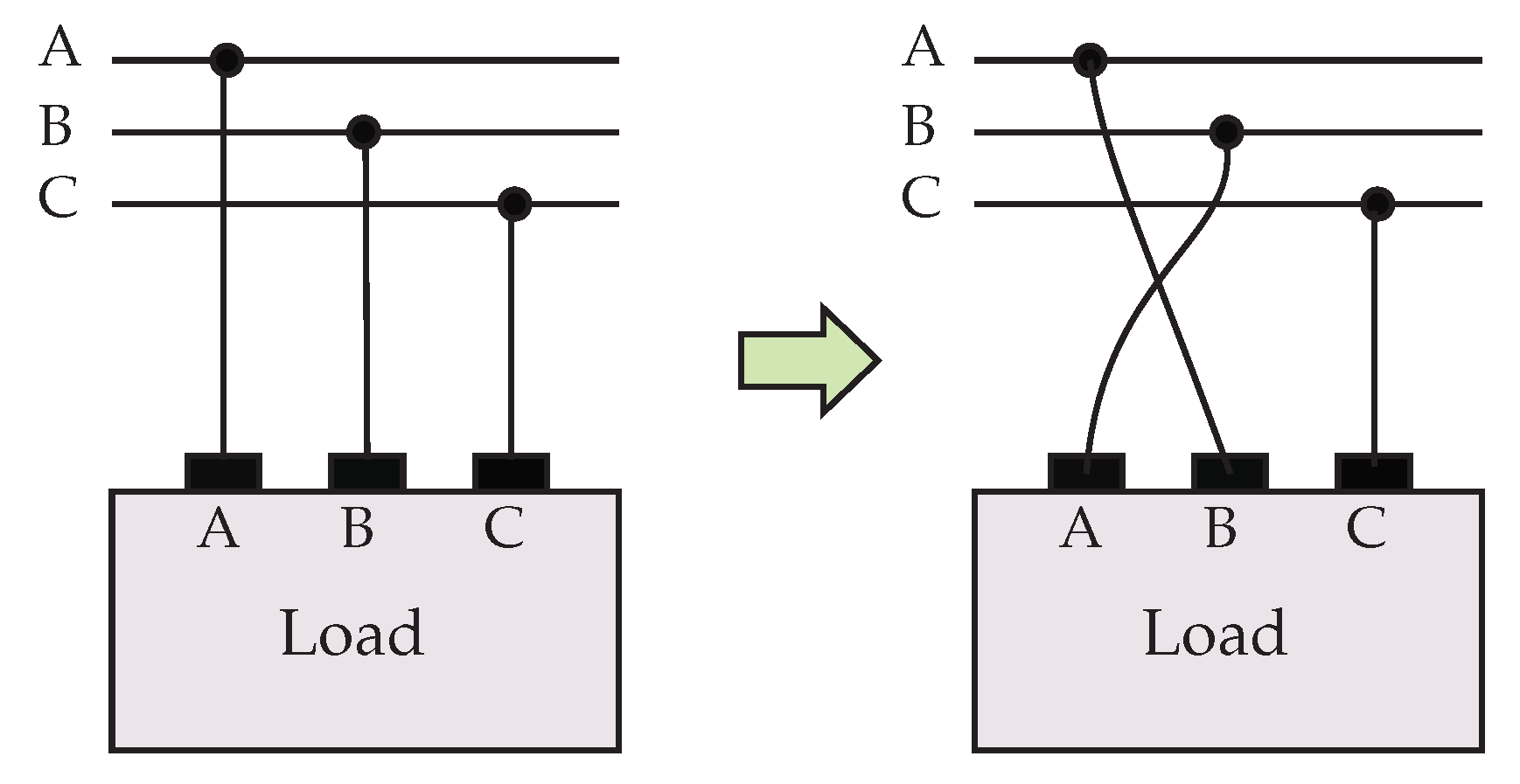
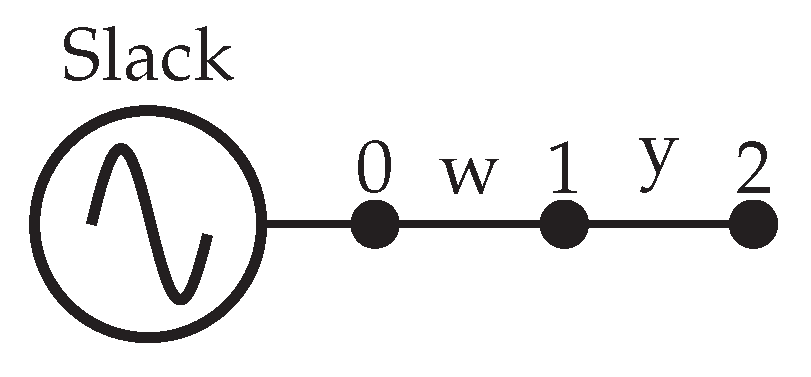

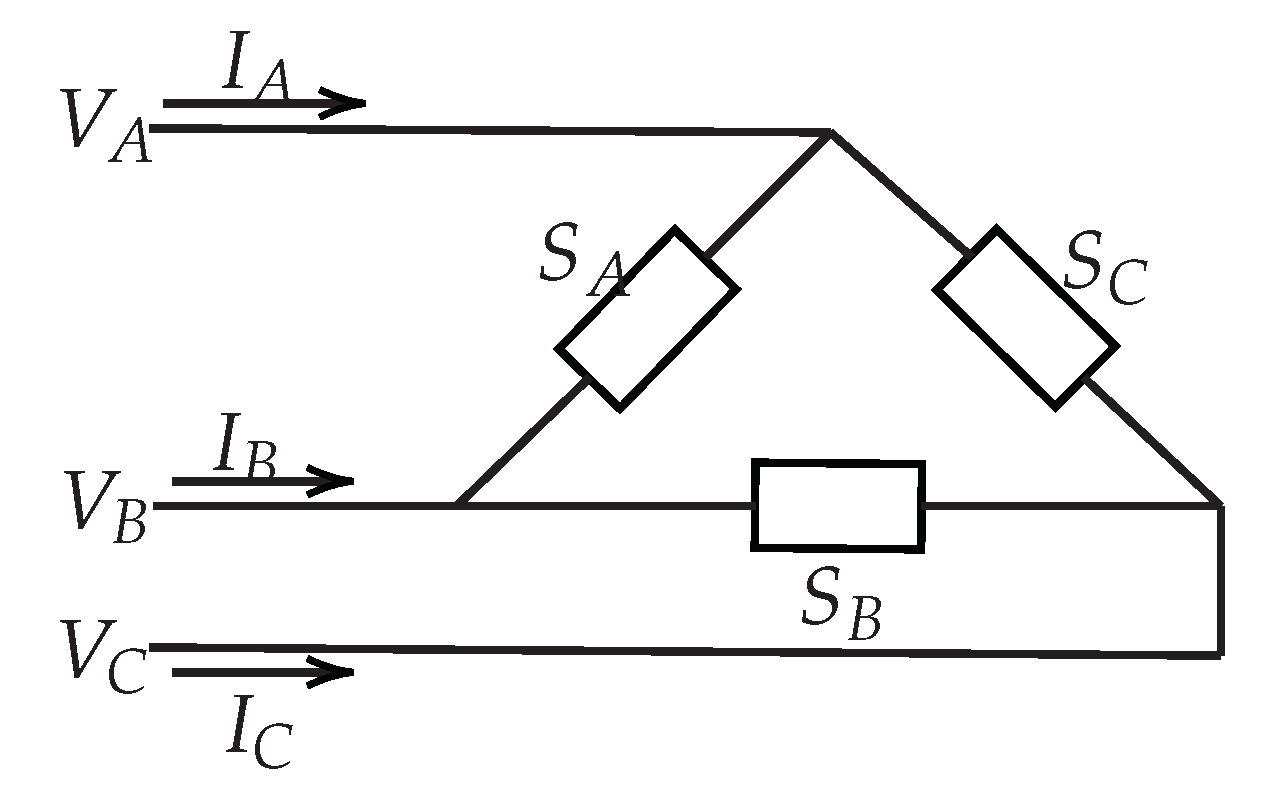
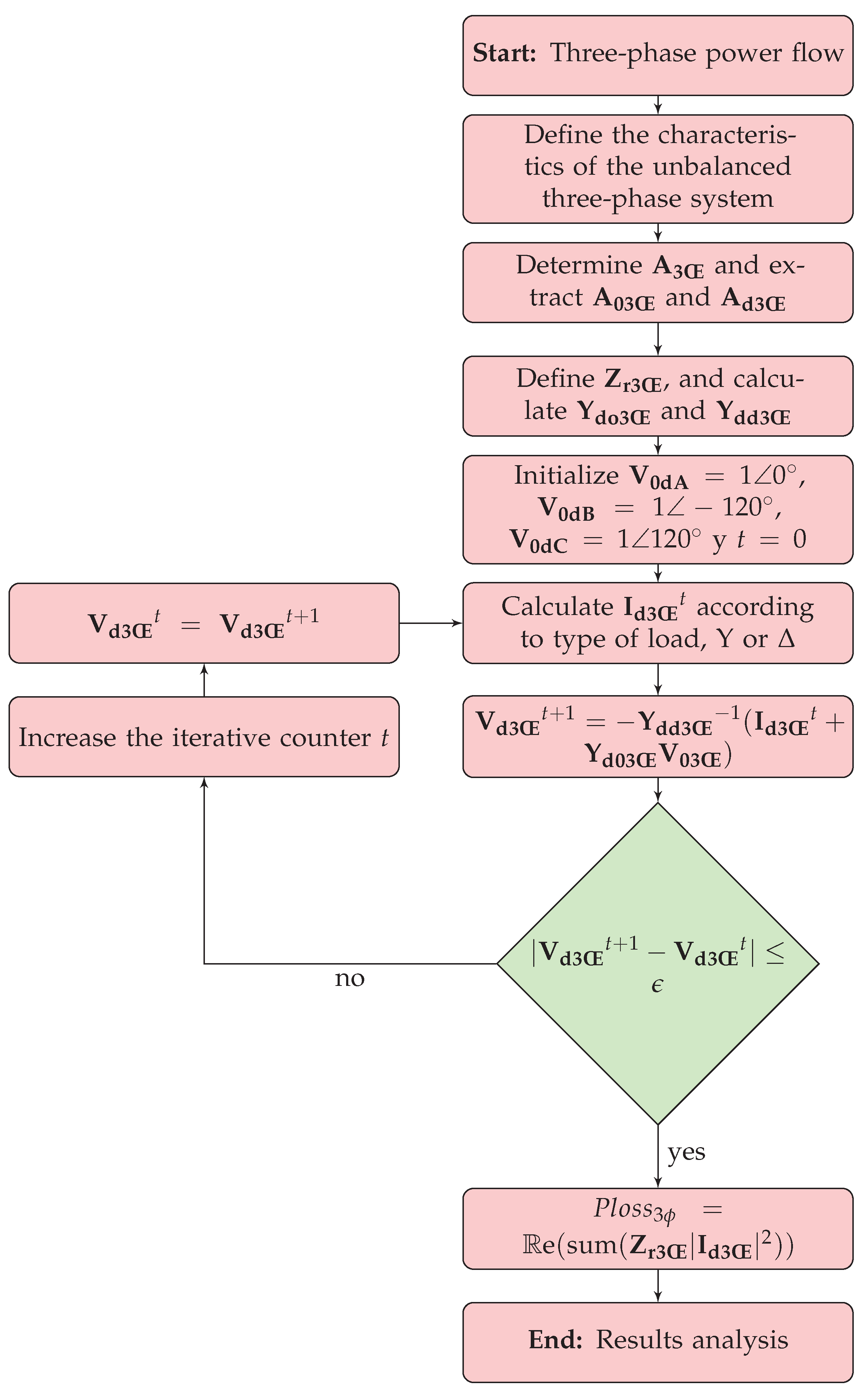
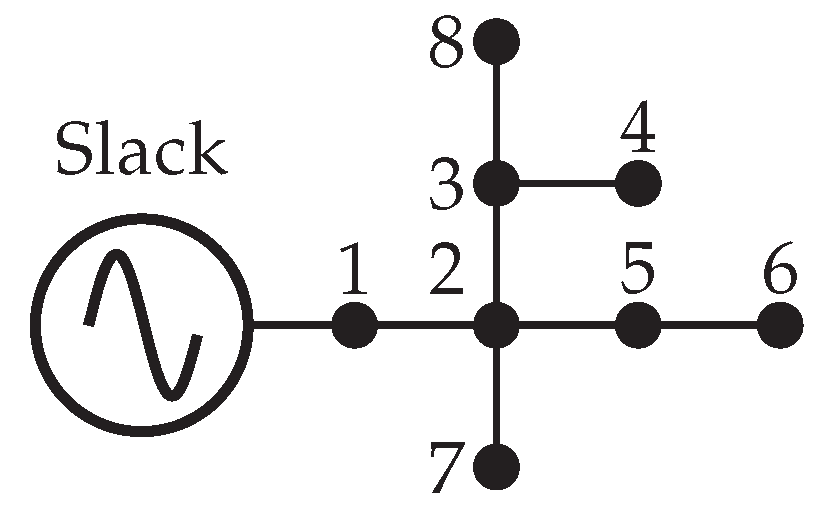
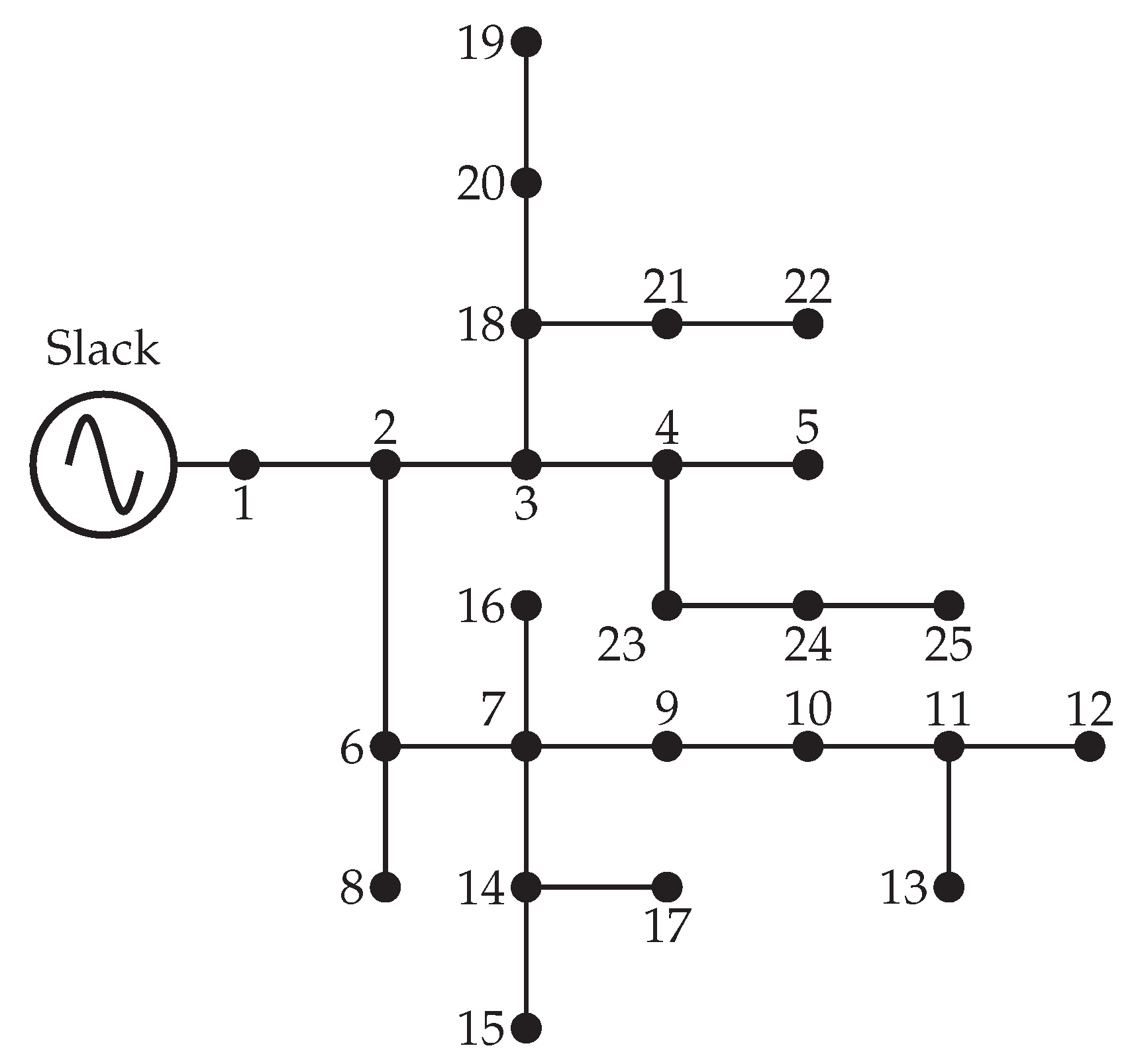

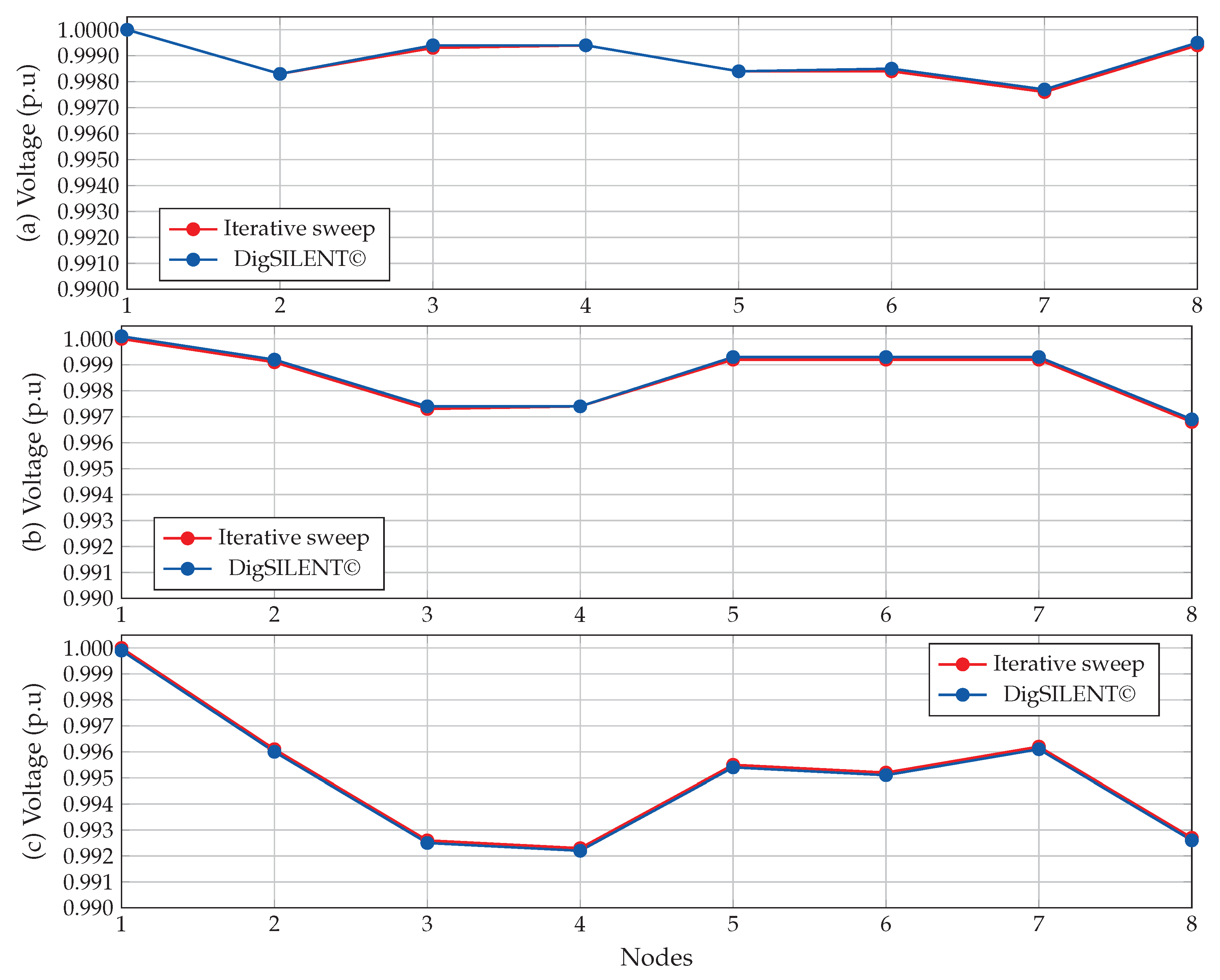
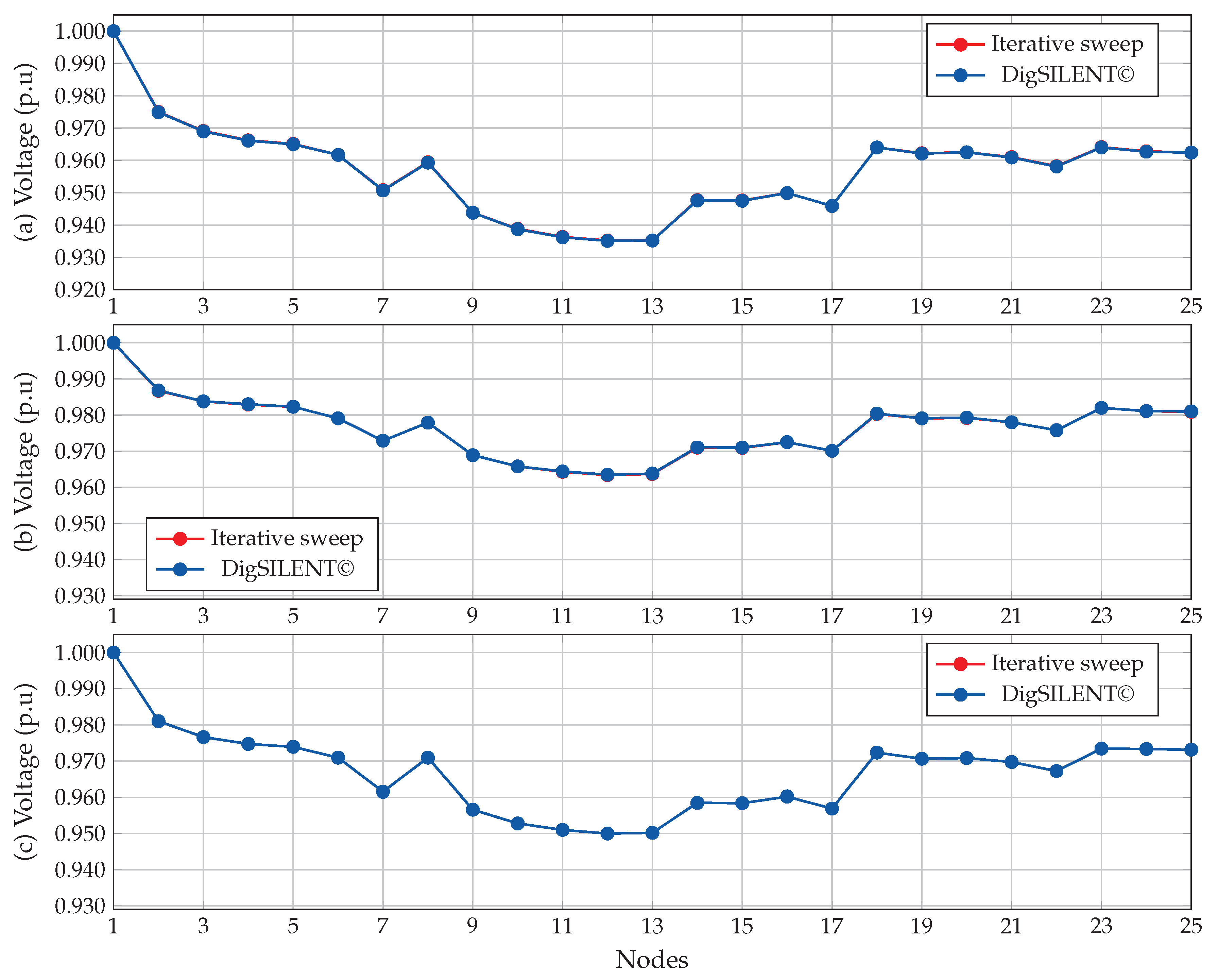



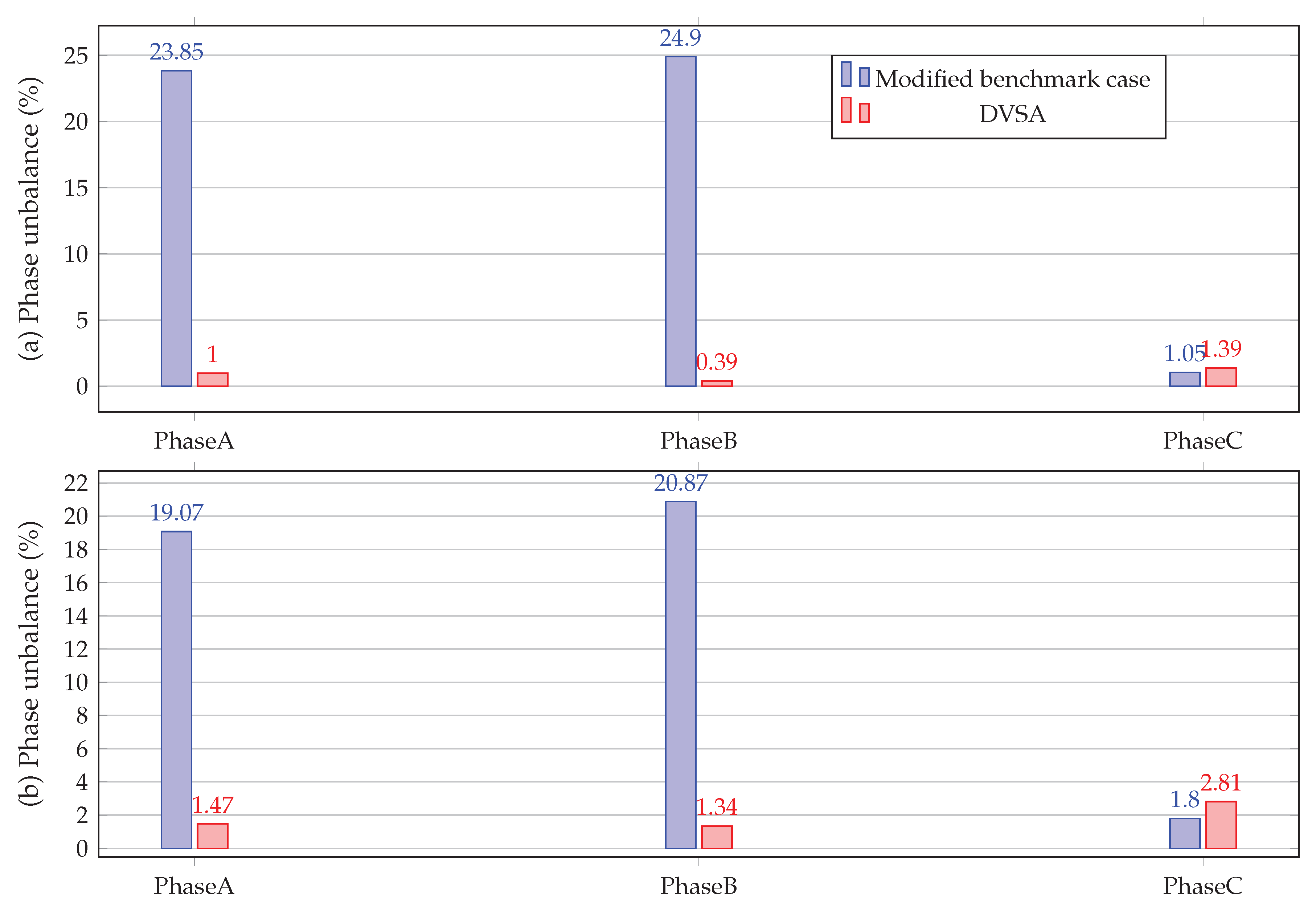
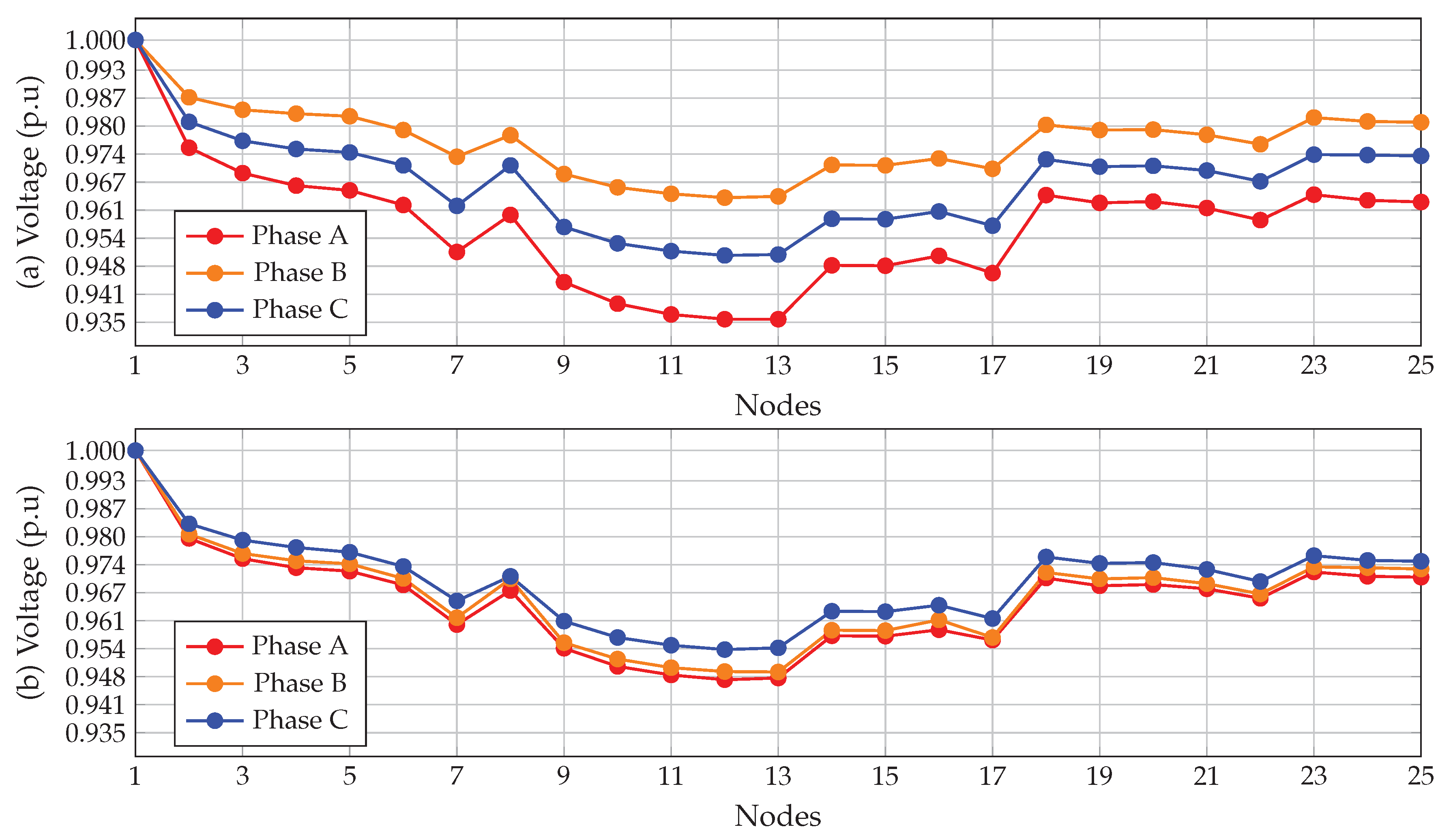
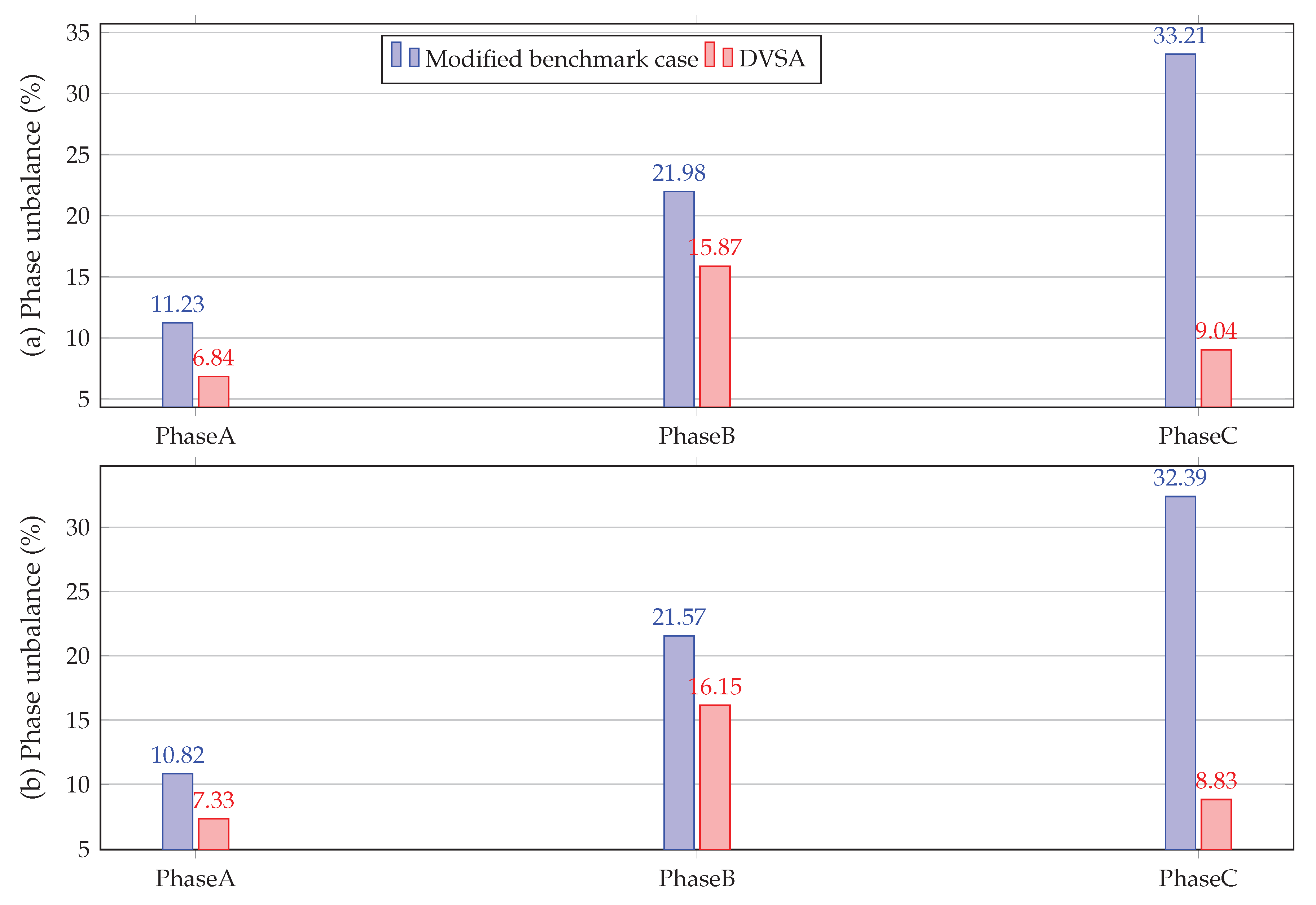
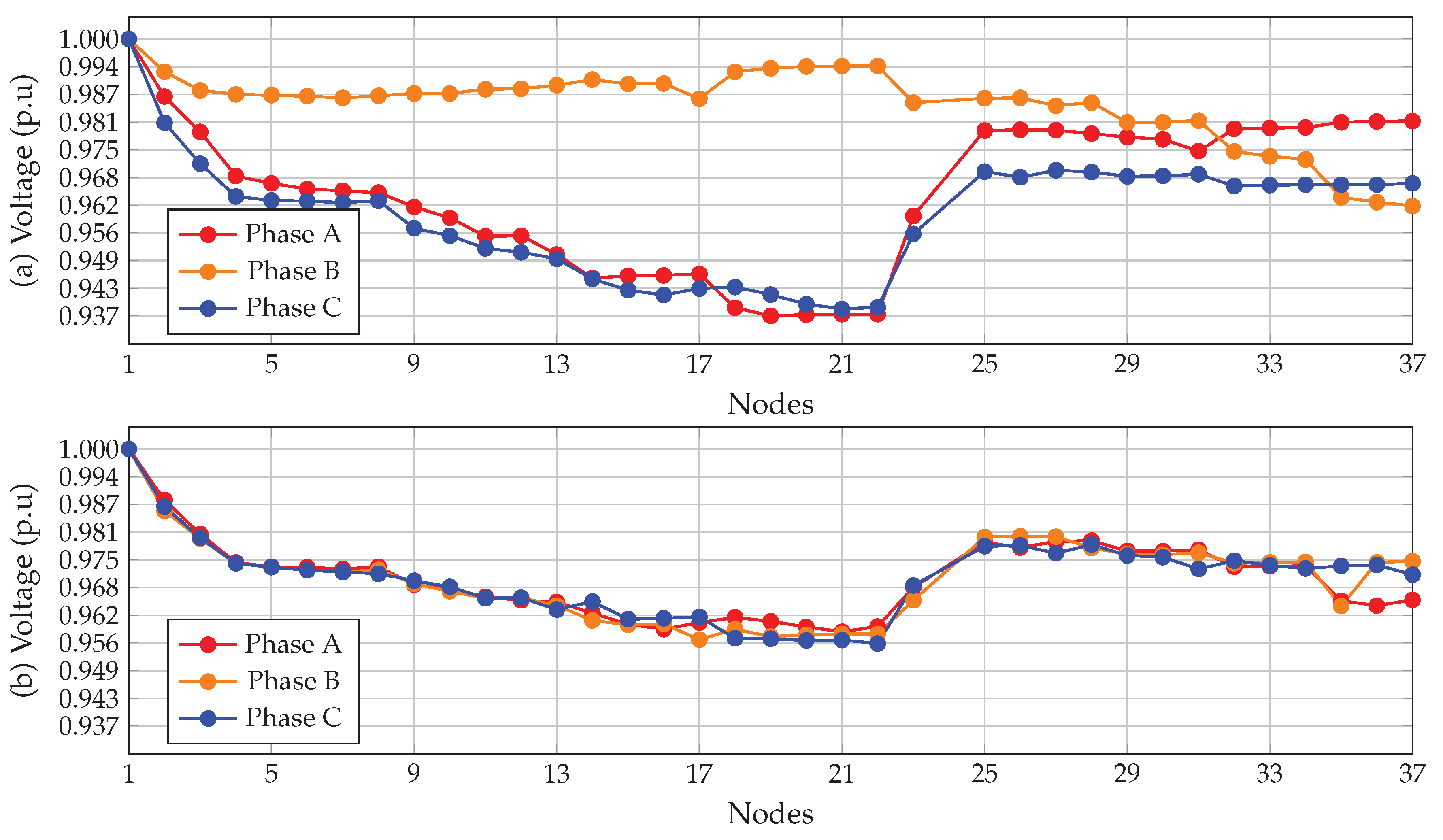
| Reference | Method/Algorithm |
|---|---|
| [16] | Mixed-integer programming |
| [17] | Simulated Annealing |
| [3,11,18,31,33] | Genetic Algorithm |
| [19,30] | Backward recurrence search heuristic algorithm |
| [20] | Ant colony optimization algorithm |
| [21,27,29] | Particle Swarm Optimization Algorithm |
| [22] | Heuristic rules |
| [23] | Immune Algorithm |
| [24] | Automatic System-Mapping |
| [25,26] | Hybrid Heuristic Algorithm |
| [8,28] | Heuristic Method |
| [32] | Analytic approach |
| Reference | Objective Function |
|---|---|
| [8,16,18,19,21,25,26,28,29,30,32] | Minimize system-unbalancing |
| [17,22,23,27] | Minimize operative costs |
| [11,24,31] | Minimize power losses |
| [3,20,33] | Minimize energy losses |
| Type of Connection (h) | Connection | Sequence |
|---|---|---|
| 1 | ABC | |
| 2 | BCA | No change |
| 3 | CAB | |
| 4 | ACB | |
| 5 | CBA | Change |
| 6 | BAC |
| MATLAB® | DigSILENT© | |||||||||||
|---|---|---|---|---|---|---|---|---|---|---|---|---|
| Node | Phase A | Phase B | Phase C | Phase A | Phase B | Phase C | ||||||
| 1 | 1.0000 | 0.0000 | 1.0000 | −120.0000 | 1.0000 | 120.0000 | 1.0000 | 0.0029 | 1.0001 | −119.9932 | 0.9999 | 119.9903 |
| 2 | 0.9983 | −0.0385 | 0.9991 | −119.9651 | 0.9961 | 120.0203 | 0.9983 | −0.0357 | 0.9992 | −119.9584 | 0.9960 | 120.0107 |
| 3 | 0.9993 | −0.0635 | 0.9973 | −119.8973 | 0.9926 | 119.9881 | 0.9994 | −0.0606 | 0.9974 | −119.8905 | 0.9925 | 119.9785 |
| 4 | 0.9994 | −0.0686 | 0.9974 | −119.8924 | 0.9923 | 119.9889 | 0.9994 | −0.0658 | 0.9974 | −119.8856 | 0.9922 | 119.9793 |
| 5 | 0.9984 | −0.0474 | 0.9992 | −119.9567 | 0.9955 | 120.0216 | 0.9984 | −0.0446 | 0.9993 | −119.9499 | 0.9954 | 120.0120 |
| 6 | 0.9984 | −0.0532 | 0.9992 | −119.9512 | 0.9952 | 120.0225 | 0.9985 | −0.0503 | 0.9993 | −119.9444 | 0.9951 | 120.0128 |
| 7 | 0.9976 | −0.0368 | 0.9992 | −119.9767 | 0.9962 | 120.0314 | 0.9977 | −0.0340 | 0.9993 | −119.9700 | 0.9961 | 120.0217 |
| 8 | 0.9994 | −0.0554 | 0.9968 | −119.8960 | 0.9927 | 119.9795 | 0.9995 | −0.0525 | 0.9969 | −119.8892 | 0.9926 | 119.9699 |
| Parameter | MATLAB® | DigSILENT© | Units |
|---|---|---|---|
| Iterations | 5 | 3 | - |
| Proc. time | 0.0905 | - | s |
| Losses phase A | 1.7158 | 1.7158 | kW |
| Losses phase B | 2.3305 | 2.3295 | kW |
| Losses phase C | 9.9462 | 9.9487 | kW |
| Total losses | 13.9925 | 13.9940 | kW |
| MATLAB® | DigSILENT© | |||||||||||
|---|---|---|---|---|---|---|---|---|---|---|---|---|
| Node | Phase A | Phase B | Phase C | Phase A | Phase B | Phase C | ||||||
| 1 | 1.0000 | 0.0000 | 1.0000 | −120.0000 | 1.0000 | 120.0000 | 1.0000 | −0.0034 | 1.0000 | −119.9965 | 1.0000 | 119.9999 |
| 2 | 0.9750 | −0.6501 | 0.9867 | −120.1361 | 0.9810 | 119.5639 | 0.9749 | −0.6536 | 0.9868 | −120.1324 | 0.9810 | 119.5638 |
| 3 | 0.9691 | −0.7637 | 0.9838 | −120.1732 | 0.9766 | 119.4572 | 0.9690 | −0.7672 | 0.9838 | −120.1695 | 0.9766 | 119.4572 |
| 4 | 0.9662 | −0.8026 | 0.9829 | −120.1871 | 0.9747 | 119.4152 | 0.9661 | −0.8061 | 0.9830 | −120.1834 | 0.9747 | 119.4151 |
| 5 | 0.9651 | −0.8077 | 0.9823 | −120.1854 | 0.9739 | 119.4129 | 0.9650 | −0.8112 | 0.9823 | −120.1817 | 0.9739 | 119.4128 |
| 6 | 0.9617 | −0.7779 | 0.9791 | −120.0724 | 0.9709 | 119.5594 | 0.9617 | −0.7814 | 0.9791 | −120.0688 | 0.9709 | 119.5593 |
| 7 | 0.9508 | −0.8995 | 0.9729 | −120.0039 | 0.9615 | 119.5421 | 0.9507 | −0.9030 | 0.9729 | −120.0002 | 0.9615 | 119.5420 |
| 8 | 0.9594 | −0.7865 | 0.9779 | −120.0855 | 0.9709 | 119.5683 | 0.9593 | −0.7900 | 0.9779 | −120.0819 | 0.9709 | 119.5683 |
| 9 | 0.9438 | −0.9633 | 0.9689 | −119.9915 | 0.9566 | 119.5386 | 0.9438 | −0.9669 | 0.9689 | −119.9878 | 0.9566 | 119.5385 |
| 10 | 0.9388 | −1.0206 | 0.9658 | −119.9830 | 0.9528 | 119.5385 | 0.9387 | −1.0241 | 0.9658 | −119.9794 | 0.9528 | 119.5385 |
| 11 | 0.9363 | −1.0512 | 0.9643 | −119.9793 | 0.9510 | 119.5371 | 0.9362 | −1.0547 | 0.9644 | −119.9757 | 0.9510 | 119.5370 |
| 12 | 0.9352 | −1.0544 | 0.9634 | −119.9785 | 0.9500 | 119.5402 | 0.9351 | −1.0580 | 0.9635 | −119.9748 | 0.9500 | 119.5402 |
| 13 | 0.9352 | −1.0713 | 0.9637 | −119.9800 | 0.9502 | 119.5376 | 0.9352 | −1.0749 | 0.9638 | −119.9763 | 0.9502 | 119.5376 |
| 14 | 0.9477 | −0.9139 | 0.9710 | −119.9886 | 0.9585 | 119.5349 | 0.9476 | −0.9174 | 0.9711 | −119.9849 | 0.9585 | 119.5348 |
| 15 | 0.9476 | −0.9147 | 0.9709 | −119.9886 | 0.9584 | 119.5344 | 0.9475 | −0.9183 | 0.9710 | −119.9850 | 0.9584 | 119.5344 |
| 16 | 0.9499 | −0.9447 | 0.9725 | −119.9626 | 0.9602 | 119.5352 | 0.9499 | −0.9482 | 0.9725 | −119.9589 | 0.9602 | 119.5352 |
| 17 | 0.9459 | −0.9111 | 0.9701 | −119.9863 | 0.9569 | 119.5378 | 0.9459 | −0.9147 | 0.9701 | −119.9826 | 0.9569 | 119.5377 |
| 18 | 0.9640 | −0.7742 | 0.9803 | −120.1533 | 0.9723 | 119.4575 | 0.9640 | −0.7777 | 0.9804 | −120.1495 | 0.9723 | 119.4574 |
| 19 | 0.9622 | −0.7770 | 0.9791 | −120.1454 | 0.9706 | 119.4561 | 0.9621 | −0.7805 | 0.9791 | −120.1417 | 0.9706 | 119.4560 |
| 20 | 0.9625 | −0.7776 | 0.9792 | −120.1456 | 0.9708 | 119.4546 | 0.9625 | −0.7811 | 0.9793 | −120.1419 | 0.9708 | 119.4545 |
| 21 | 0.9610 | −0.7735 | 0.9780 | −120.1467 | 0.9697 | 119.4701 | 0.9609 | −0.7770 | 0.9780 | −120.1429 | 0.9697 | 119.4700 |
| 22 | 0.9582 | −0.7730 | 0.9758 | −120.1403 | 0.9672 | 119.4825 | 0.9581 | −0.7765 | 0.9758 | −120.1366 | 0.9672 | 119.4824 |
| 23 | 0.9641 | −0.7590 | 0.9820 | −120.1890 | 0.9734 | 119.4163 | 0.9640 | −0.7626 | 0.9820 | −120.1853 | 0.9734 | 119.4163 |
| 24 | 0.9628 | −0.7599 | 0.9811 | −120.1954 | 0.9733 | 119.4204 | 0.9627 | −0.7634 | 0.9811 | −120.1917 | 0.9733 | 119.4203 |
| 25 | 0.9624 | −0.7593 | 0.9809 | −120.1960 | 0.9731 | 119.4210 | 0.9624 | −0.7628 | 0.9810 | −120.1922 | 0.9731 | 119.4209 |
| Parameter | MATLAB® | DigSILENT© | Units |
|---|---|---|---|
| Iterations | 9 | 4 | |
| Proc. time. | 0.1882 | - | s |
| Losses on phase A | 36.8801 | 36.8844 | kW |
| Losses on phase B | 14.7837 | 14.7835 | kW |
| Losses on phase C | 23.7570 | 23.7553 | kW |
| Total losses | 75.4207 | 75.4232 | kW |
| MATLAB® | DigSILENT© | |||||||||||
|---|---|---|---|---|---|---|---|---|---|---|---|---|
| Node | Phase A | Phase B | Phase C | Phase A | Phase B | Phase C | ||||||
| 1 | 1.0000 | 0.0000 | 1.0000 | −120.0000 | 1.0000 | 120.0000 | 1.0000 | 0.0016 | 1.0000 | −119.9965 | 0.9999 | 119.9949 |
| 2 | 0.9868 | −0.2074 | 0.9925 | −120.2320 | 0.9808 | 119.6710 | 0.9868 | −0.2057 | 0.9925 | −120.2286 | 0.9808 | 119.6659 |
| 3 | 0.9787 | −0.3596 | 0.9882 | −120.3445 | 0.9714 | 119.4834 | 0.9787 | −0.3580 | 0.9882 | −120.3410 | 0.9714 | 119.4783 |
| 4 | 0.9686 | −0.5260 | 0.9873 | −120.4685 | 0.9639 | 119.3764 | 0.9686 | −0.5244 | 0.9873 | −120.4651 | 0.9638 | 119.3713 |
| 5 | 0.9669 | −0.5214 | 0.9871 | −120.4719 | 0.9630 | 119.3994 | 0.9669 | −0.5197 | 0.9871 | −120.4685 | 0.9629 | 119.3943 |
| 6 | 0.9656 | −0.5230 | 0.9869 | −120.4906 | 0.9628 | 119.4125 | 0.9656 | −0.5214 | 0.9870 | −120.4872 | 0.9628 | 119.4074 |
| 7 | 0.9652 | −0.5192 | 0.9865 | −120.4866 | 0.9625 | 119.4153 | 0.9652 | −0.5176 | 0.9866 | −120.4832 | 0.9624 | 119.4102 |
| 8 | 0.9648 | −0.5182 | 0.9870 | −120.5004 | 0.9629 | 119.4214 | 0.9648 | −0.5165 | 0.9871 | −120.4970 | 0.9629 | 119.4164 |
| 9 | 0.9615 | −0.6532 | 0.9875 | −120.4656 | 0.9566 | 119.4366 | 0.9615 | −0.6516 | 0.9876 | −120.4622 | 0.9566 | 119.4315 |
| 10 | 0.9590 | −0.6832 | 0.9875 | −120.4774 | 0.9549 | 119.4585 | 0.9590 | −0.6816 | 0.9875 | −120.4740 | 0.9548 | 119.4534 |
| 11 | 0.9548 | −0.7519 | 0.9885 | −120.4953 | 0.9520 | 119.5149 | 0.9549 | −0.7503 | 0.9886 | −120.4919 | 0.9519 | 119.5098 |
| 12 | 0.9549 | −0.7631 | 0.9886 | −120.4837 | 0.9511 | 119.5206 | 0.9549 | −0.7614 | 0.9887 | −120.4803 | 0.9510 | 119.5155 |
| 13 | 0.9506 | −0.8107 | 0.9894 | −120.5233 | 0.9496 | 119.5721 | 0.9506 | −0.8091 | 0.9895 | −120.5199 | 0.9495 | 119.5671 |
| 14 | 0.9452 | −0.9099 | 0.9907 | −120.5351 | 0.9450 | 119.6411 | 0.9452 | −0.9083 | 0.9907 | −120.5317 | 0.9450 | 119.6361 |
| 15 | 0.9457 | −0.9273 | 0.9897 | −120.4865 | 0.9424 | 119.6372 | 0.9457 | −0.9257 | 0.9897 | −120.4831 | 0.9423 | 119.6322 |
| 16 | 0.9458 | −0.9413 | 0.9898 | −120.4717 | 0.9413 | 119.6429 | 0.9459 | −0.9397 | 0.9898 | −120.4683 | 0.9412 | 119.6379 |
| 17 | 0.9461 | −0.8802 | 0.9863 | −120.4621 | 0.9428 | 119.5912 | 0.9462 | −0.8786 | 0.9864 | −120.4587 | 0.9428 | 119.5862 |
| 18 | 0.9384 | −0.9814 | 0.9925 | −120.6104 | 0.9431 | 119.7487 | 0.9384 | −0.9798 | 0.9926 | −120.6070 | 0.9430 | 119.7437 |
| 19 | 0.9365 | −1.0243 | 0.9933 | −120.6123 | 0.9414 | 119.7785 | 0.9365 | −1.0227 | 0.9933 | −120.6089 | 0.9413 | 119.7735 |
| 20 | 0.9368 | −1.0644 | 0.9937 | −120.5738 | 0.9392 | 119.7744 | 0.9368 | −1.0628 | 0.9937 | −120.5704 | 0.9392 | 119.7694 |
| 21 | 0.9369 | −1.0786 | 0.9938 | −120.5589 | 0.9381 | 119.7802 | 0.9370 | −1.0770 | 0.9939 | −120.5555 | 0.9381 | 119.7752 |
| 22 | 0.9369 | −1.0779 | 0.9938 | −120.5611 | 0.9385 | 119.7738 | 0.9369 | −1.0763 | 0.9939 | −120.5577 | 0.9384 | 119.7688 |
| 23 | 0.9594 | −0.6451 | 0.9854 | −120.4788 | 0.9553 | 119.4189 | 0.9594 | −0.6435 | 0.9855 | −120.4754 | 0.9552 | 119.4139 |
| 25 | 0.9790 | −0.3561 | 0.9864 | −120.3058 | 0.9696 | 119.4690 | 0.9790 | −0.3545 | 0.9864 | −120.3024 | 0.9695 | 119.4639 |
| 26 | 0.9792 | −0.3720 | 0.9865 | −120.2884 | 0.9683 | 119.4755 | 0.9792 | −0.3704 | 0.9866 | −120.2850 | 0.9683 | 119.4704 |
| 27 | 0.9791 | −0.3321 | 0.9847 | −120.2979 | 0.9699 | 119.4490 | 0.9791 | −0.3304 | 0.9848 | −120.2945 | 0.9698 | 119.4439 |
| 28 | 0.9783 | −0.3479 | 0.9854 | −120.3203 | 0.9695 | 119.4309 | 0.9783 | −0.3463 | 0.9854 | −120.3169 | 0.9694 | 119.4258 |
| 29 | 0.9775 | −0.2986 | 0.9809 | −120.3178 | 0.9685 | 119.3591 | 0.9775 | −0.2970 | 0.9809 | −120.3144 | 0.9685 | 119.3540 |
| 30 | 0.9770 | −0.2947 | 0.9809 | −120.3238 | 0.9686 | 119.3639 | 0.9770 | −0.2931 | 0.9809 | −120.3203 | 0.9686 | 119.3588 |
| 31 | 0.9743 | −0.2809 | 0.9813 | −120.3595 | 0.9690 | 119.3973 | 0.9743 | −0.2793 | 0.9813 | −120.3561 | 0.9689 | 119.3922 |
| 32 | 0.9794 | −0.2276 | 0.9742 | −120.2509 | 0.9663 | 119.2086 | 0.9794 | −0.2260 | 0.9742 | −120.2475 | 0.9663 | 119.2035 |
| 33 | 0.9796 | −0.2090 | 0.9731 | −120.2502 | 0.9665 | 119.1887 | 0.9797 | −0.2074 | 0.9732 | −120.2468 | 0.9664 | 119.1836 |
| 34 | 0.9797 | −0.1990 | 0.9724 | −120.2447 | 0.9666 | 119.1788 | 0.9797 | −0.1974 | 0.9724 | −120.2413 | 0.9665 | 119.1737 |
| 35 | 0.9809 | −0.0984 | 0.9637 | −120.1553 | 0.9666 | 119.0732 | 0.9809 | −0.0968 | 0.9637 | −120.1519 | 0.9665 | 119.0682 |
| 36 | 0.9811 | −0.0859 | 0.9626 | −120.1451 | 0.9666 | 119.0599 | 0.9811 | −0.0843 | 0.9627 | −120.1416 | 0.9665 | 119.0548 |
| 37 | 0.9812 | −0.0708 | 0.9617 | −120.1400 | 0.9669 | 119.0462 | 0.9812 | −0.0692 | 0.9617 | −120.1366 | 0.9668 | 119.0411 |
| Parameter | MATLAB® | DigSILENT© | Units |
|---|---|---|---|
| Iterations | 9 | 4 | - |
| Proc. time | 0.2919 | - | s |
| Losses on phase A | 27.1532 | 27.1533 | kW |
| Losses on phase B | 11.9143 | 11.9121 | kW |
| Losses on phase C | 37.0683 | 37.0732 | kW |
| Total losses | 76.1357 | 76.1386 | kW |
| Discrete Vortex Search Algorithm | |
|---|---|
| Number of candidate solutions | 10 |
| Number of iterations | 800 |
| Iterations to stop the process | 250 |
| Generation of the candidate solution | Gaussian distribution |
| Three-Phase Iterative Sweep Power Flow | |
| Number of iterations | 1000 |
| Tolerance | |
| Tests per System | |
| Number of evaluations | 100 |
| Method | Connections | Phase A (kW) | Phase B (kW) | Phase C (kW) | Total (kW) |
|---|---|---|---|---|---|
| Mod. benchmark case | 1.7158 | 2.3305 | 9.9462 | 13.9925 | |
| CBGA | 2.7295 | 4.0957 | 3.7617 | 10.5869 | |
| DVSA | 2.7295 | 4.0957 | 3.7617 | 10.5869 | |
| DigSILENT© | 2.7294 | 4.0957 | 3.7619 | 10.5869 |
| Method | Connections | Ph. A (kW) | Ph. B (kW) | Ph. C (kW) | Total (kW) |
|---|---|---|---|---|---|
| Mod. benchmark case | {1,1,1,1,1,1,1,1,1,1,1,1,1,1, 1,1,1,1,1,1,1,1,1,1} | 36.8801 | 14.7837 | 23.757 | 75.4207 |
| CBGA | {1,1,3,5,2,1,1,1,2,6,5,1,5,3, 6,6,3,3,1,3,5,2,4,3} | 25.7626 | 25.9510 | 20.5782 | 72.2919 |
| DVSA | {1,2,4,5,6,1,2,3,1,5,4,3,3,5, 5,2,3,3,5,4,2,2,2,3} | 25.6645 | 26.1613 | 20.4630 | 72.2888 |
| DigSILENT© | {1,2,4,5,6,1,2,3,1,5,4,3,3,5, 5,2,3,3,5,4,2,2,2,3} | 25.6644 | 26.1642 | 20.4601 | 72.2887 |
| Method | Connections | Ph. A (kW) | Ph. B (kW) | Ph. C (kW) | Total (kW) |
|---|---|---|---|---|---|
| Mod. benchmark case | {1,1,1,1,1,1,1,1,1,1,1,1,1,1, 1,1,1,1,1,1,1,1,1,1,1,1,1,1, 1,1,1,1,1,1,1} | 27.1532 | 11.9143 | 37.0683 | 76.1357 |
| CBGA | {4,1,1,6,4,4,6,4,1,1,6,5,2,1, 2,3,1,5,1,4,3,2,6,5,3,2,1,6, 5,2,1,4,1,2,3} | 19.9434 | 20.8957 | 20.739 | 61.5785 |
| DVSA | {4,1,1,5,3,4,2,3,1,1,3,2,2,1, 3,5,2,3,1,3,6,1,2,3,3,2,1,1, 2,4,1,4,1,2,4} | 21.0656 | 21.6989 | 18.7155 | 61.4801 |
| DigSILENT© | {4,1,1,5,3,4,2,3,1,1,3,2,2,1, 3,5,2,3,1,3,6,1,2,3,3,2,1,1, 2,4,1,4,1,2,4} | 21.0644 | 21.7005 | 18.7153 | 61.4802 |
Publisher’s Note: MDPI stays neutral with regard to jurisdictional claims in published maps and institutional affiliations. |
© 2021 by the authors. Licensee MDPI, Basel, Switzerland. This article is an open access article distributed under the terms and conditions of the Creative Commons Attribution (CC BY) license (http://creativecommons.org/licenses/by/4.0/).
Share and Cite
Cortés-Caicedo, B.; Avellaneda-Gómez, L.S.; Montoya, O.D.; Alvarado-Barrios, L.; Chamorro, H.R. Application of the Vortex Search Algorithm to the Phase-Balancing Problem in Distribution Systems. Energies 2021, 14, 1282. https://doi.org/10.3390/en14051282
Cortés-Caicedo B, Avellaneda-Gómez LS, Montoya OD, Alvarado-Barrios L, Chamorro HR. Application of the Vortex Search Algorithm to the Phase-Balancing Problem in Distribution Systems. Energies. 2021; 14(5):1282. https://doi.org/10.3390/en14051282
Chicago/Turabian StyleCortés-Caicedo, Brandon, Laura Sofía Avellaneda-Gómez, Oscar Danilo Montoya, Lazaro Alvarado-Barrios, and Harold R. Chamorro. 2021. "Application of the Vortex Search Algorithm to the Phase-Balancing Problem in Distribution Systems" Energies 14, no. 5: 1282. https://doi.org/10.3390/en14051282
APA StyleCortés-Caicedo, B., Avellaneda-Gómez, L. S., Montoya, O. D., Alvarado-Barrios, L., & Chamorro, H. R. (2021). Application of the Vortex Search Algorithm to the Phase-Balancing Problem in Distribution Systems. Energies, 14(5), 1282. https://doi.org/10.3390/en14051282










